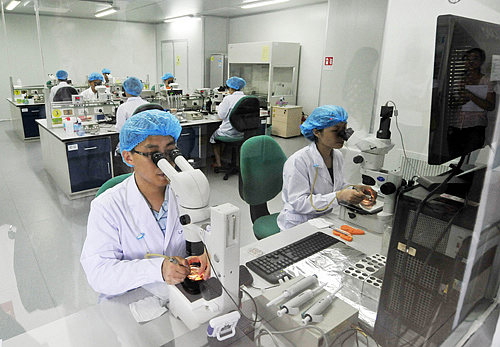|
 |
|
DEDICATED TO SCIENCE: Researchers of the Beijing Genomics Institute examine genes under high-powered microscopes in Shenzhen, the institute's new headquarters (CHEN XIAOHUA) |
Urban and rural regional development will be more coordinated. The widening gap between rural and urban residents will be effectively contained, as will the gap in public services to rural and urban areas. Urban-rural and regionally coordinated development mechanisms and major functional areas will take shape.
The socialist market economic system will be further perfected. Reform and institutional construction in such fields as administrative governance, state-owned and public undertakings, finance and taxation will make major breakthroughs. The price-forming mechanism of production factors and resources that can reflect market demand and supply, rareness of resources and environment damage costs will be improved. A modern society credit system will be in the main formed.
Socialist political and cultural construction will also witness new breakthroughs. Citizens' participation in politics will be expanded. The self-governance of villagers will be improved and direct suffrage of neighborhood committees in cities will be encouraged and are expected to rise above 75 percent by 2015. The cultural industry will be revitalized, with its proportion of GDP increasing gradually.
Compared with the 11th Five-Year Plan, what are the features of the major indexes in the 12th Five-Year Plan?
There might be 24 major indexes in the 12th Five-Year Plan—two more than the previous one. While I won't name them all, they have the following basic features.
First, the new plan is a combination of continuing with the old and innovating with the new. The 12th Five-Year Plan attaches great importance to the continuation of the 11th Five-Year Plan, but also makes some innovations and readjustments in accordance with developing situations. As a result, we suggested keeping nine of the previous indexes, adjusting six, and adopting nine new ones. The new indexes mainly focus on fields relating to public services, resources, environments and people's lives.
Second, top priority is being given to the public service index, supplemented by economic indexes, which reflects the enormous change and transition of the government function.
Third, priority is also being given to binding indexes, supplemented by predicted indexes, which reflect the government's determination to enhance public services.
Fourth, the indexes will be integrated with international standards. For instance, China will adopt the human development index as the most important index to measure whether or not it has entered a well-off society.
Fifth, the indexes can all be observed, measured, compared and evaluated and have clear time frames.
In addition, I suggest China further downplay and reduce economic indexes, while enhancing and increasing green development indexes as well as establishing a political accomplishment evaluation system focused on green development.
What measures should be adopted if China is going to achieve the economic targets in the 12th Five-Year Plan?
To ensure sound and fast economic development, China must shift its economic development pattern. It should rely less on export for growth and more on consumption and investment. The primary, secondary and tertiary industries will all become equal driving forces of economic development rather than relying solely on secondary or heavy industries. Economic growth will be mainly driven by technological progress, employee talent and management innovation instead of the old pattern of resource consumption.
Industrial optimization will be China's top priority.
To achieve this optimization, China will need to speed up developing a modern service industry. China will follow the direction of marketization, industrialization and socialization by promoting producer-oriented service industries, detailing and deepening divisions of labor, maximizing the proportion of added value of the service industry, and promoting jobs in the service industry. The proportion of added value of the knowledge-intensive service industry in GDP will be increased to above 13 percent by 2015 from 10.6 percent in 2007.
In the next five years, China will strive to develop its hi-tech industry. It will do this by supporting the formation of industrial clusters, raising its international competitiveness, and further developing its information technology, biology, new material, aerospace and marine industries. And a transformation will occur in the hi-tech industry, whereby China will change from its assembly line role for foreign companies into an indigenous research and development hub. In the coming years, Chinese businesses will edge their way into the global top 500, or top 2,000, companies.
Industrial optimization will also require China to develop its modern industrial system—which requires the integration of informationization and industrialization and making upgrades in technology. The country must also promote the green industry and speed up the development of this industry with low resource consumption, less environment pollution and sound economic profit while restricting high energy consumption industries (iron and steel, petrochemical and chemical) and abandoning outdated production methods. Modernizing the national infrastructure will also be a critical component to industrial optimization, and China will speed up construction of high-speed rail networks, expressways, intelligent power grids and natural resource networks.
| 